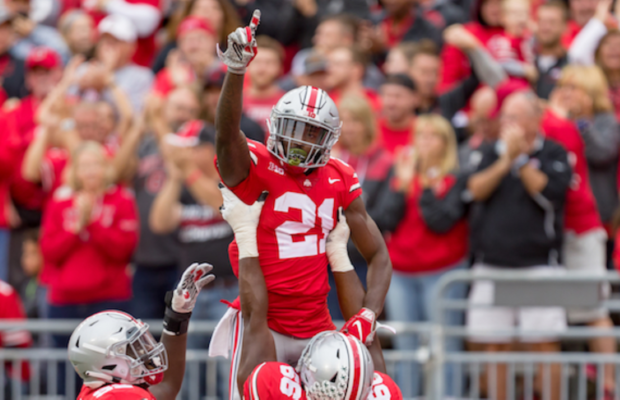The Pro Factory: How Ohio State’s WR Room Churns Out Beasts

Ohio State’s wide receiver room is a bonafide pro factory.
Since 2015, eight Buckeye receivers have been drafted into the NFL.
The pipeline likely won’t dry up anytime soon, as Ohio State’s top-ranked offense heavily features talented receivers such as Chris Olave, K.J. Hill and Binjimen Victor.
Prior to the season, STACK spoke with Brian Hartline, the former NFL receiver who now serves as the Buckeyes’ receivers coach, to find out what makes Ohio State’s receivers “different” from the competition.
The ultimate goal behind every route a Buckeye receiver runs is to create as much separation between the break point and the catch point as possible. Ankle-breaking releases off the line may go viral on Instagram, but according to Hartline, it’s what you do at the top of the pattern that matters more for getting open.
“To me, too many times, you can have a great release and still not end up being open at the end of the route,” Hartline says.
“To dive into our terminology, the most important part of every route, is from break point to catch point. And that means the point at which you break into the route, the most important part is your ability to separate out of a break and arrive at the catch point with as much separation as possible from the DB. If not, at the very least, a foot is all we need. Get our hands in front of his hands and make the play.”
It sounds simple, but a ton goes into squeezing as much separation as possible out of those moments. In a tweet from January, Hartline detailed how a receiver’s eyes can be a crucial tool for creating space:
Route Running is a craft; and your eyes are a huge part of it! Flash your eyes to sell the DB a route you aren’t running, stare down the defender to freeze him and save leverage or work your eyes at the TopEnd to win in transition…
We are just getting started. #Zone6 pic.twitter.com/EoXSNtpFrJ
— Brian Hartline (@brianhartline) January 17, 2019
The room also prides itself on developing drills that closely mimic the rigors of a game. Although they have a number of standbys that will likely always be a staple of their routine, they’re not afraid to experiment.
Hartline believes feedback from the players is the single most important factor when innovating better ways to practice.
“There’s always little specifics where we identify weaknesses or weaker areas in our game on film, and then we just recreate them. It’s not science, it takes effort. But you watch things, you identify things, then you go, ‘How do we create that in a one-on-one or two-on-two atmosphere to enhance that skill?’,” Hartline says.
“We try to take specific events or opportunities in-game and recreate them in drill work. And that’s essentially it. A lot of dialog goes into it, we communicate a lot with our players. The best feedback you can ever get is talking to your players. ‘What did you like? What didn’t you like? Did you like this drill? If you didn’t, why not? If you liked it, why’d you like it?’ Then you enhance from there. So we take a lot of pride in our drill work here at Ohio State and if something’s not working or we’re not seeing a lot of it, well guess what, we don’t do it a lot.”
HOW ARE YOU IMPROVING TODAY? 🚨
The difference this morning between “just catching balls” and Training with a Purpose is WANT TO…but the difference next Fall will be 6 points.. make the investment! #1%Better #BeDifferent pic.twitter.com/oOIe5u8qI1— Keenan Bailey (@CoachKee) February 5, 2019
Since there are only so many practice hours in a week, Hartline or assistant wide receivers coach Keenan Bailey will often detail how to execute certain drills to their players so the guys feel comfortable drilling it on their own or with teammates. A video system allows players to film their personal drill work so they can analyze it with coaches later on.
“Our best coaching tool is video. We use that accordingly,” Hartline says.
There are also no “plays off” inside Ohio State’s receivers room. Even if they’re not catching a pass, they want to make an impact and create winning opportunities for teammates.
“We don’t operate in this room trying to be like anyone else, we’re trying to be different. We’re always trying to be different. We’re trying to be the guy that when you’re not on the field, we feel you not being there. The only way to be irreplaceable is to be different. And that’s our mindset in our room,” Hartline says.
“(Former Ohio State receiver) Terry (McLaurin) takes that approach to the heart, and he’ll find any edge to be different than the next guy and to be better than the next guy and more cherished than the next guy. Blocking for his teammates, sacrificing on special teams, at an elite level. That takes a really honed-in mentality to accomplish that. Anybody can do it maybe once or twice, anybody can hit the same shot Michael Jordan has hit, but how often? In what critical situations is it being performed?”
To be honest, doing this makes me happier than scoring 💪🏾 pic.twitter.com/Rqpg4cFPpV
— Terry McLaurin (@TheTerry_25) September 23, 2018
Although Ohio State’s player development and recruiting are among the best in the nation, the competitive culture among teammates is also a critical piece of the puzzle.
“I know it’s used a lot, but iron sharpens iron,” says Hartline.
“They always wanna be the best one in the group, and if the group is really good, then they’re getting even better.”
Photo Credit: Adam Lacy/Getty Images
Read the original article in Stack.com by Brandon Hall.
